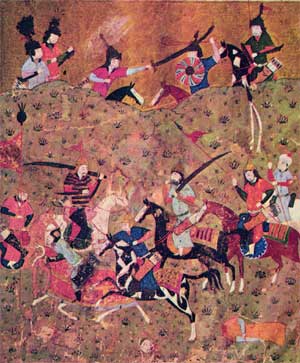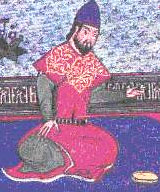|
Al-Kunduri
Amid al-Mulk Abu Nasr al-Kunduri ( fa, عمیدالملک ابونصر الکندری; 1024 – 29 November 1064), commonly known as al-Kunduri (; also spelled Kunduri), was a Persian; bureaucrat, who served as the vizier of the first Seljuk Sultan Tughril () and his nephew Alp Arslan (). Kunduri was born in Kundur. He was recruited into the Seljuk bureaucracy as a secretary, at the suggestion of his teacher, Imam al-Muwaffaq al-Nishapuri. A natural schemer, Kunduri sought to exploit the power and influence over the Seljuk sultan. Kunduri's first scheme was during his early vizierate when Tughril had tasked him to arrange a marriage between Tughril and a princess from the family of the Khwarazmshah. Instead, Kunduri arranged the marriage for himself. Kunduri subsequently went to Tughril, where he absolved himself by shaving off his beard and castrating himself. While Tughril was preparing a march towards Mosul to fight the local contender al-Basasiri in 1057, Kunduri plott ... [...More Info...] [...Related Items...] OR: [Wikipedia] [Google] [Baidu] |
Nizam Al-Mulk
Abu Ali Hasan ibn Ali Tusi (April 10, 1018 – October 14, 1092), better known by his honorific title of Nizam al-Mulk ( fa, , , Order of the Realm) was a Persian scholar, jurist, political philosopher and Vizier of the Seljuk Empire. Rising from a lowly position within the empire, he effectively became the ''de-facto'' ruler of the empire for 20 years after the assassination of Sultan Alp Arslan in 1072, serving as the archetypal "good vizier". Viewed by many historians as "the most important statesman in Islamic history", the policies implemented by Nizam al-Mulk would go on to remain as the basic foundation for administrative state structures in the Muslim world up until the 20th Century. One of his most important legacies was the founding of the madrasa system in cities across the Seljuk Empire which were called the ''Nizamiyyas'' after him. This was seen to be as the first government sponsored education system in history and as the inspiration behind the university system ... [...More Info...] [...Related Items...] OR: [Wikipedia] [Google] [Baidu] |
Kondor, Razavi Khorasan
Kondor ( fa, کندر; also Romanized as Kondowr and Kundar) is a city in Sheshtaraz District, Khalilabad County, Razavi Khorasan Province, Iran. At the 2006 census, its population was 5,700, in 1,610 families. "Kondor" means " frankincense" in Persian. Al-Kunduri, a prominent Persian vizier of the Seljuq Empire The Great Seljuk Empire, or the Seljuk Empire was a high medieval, culturally Turko-Persian, Sunni Muslim empire, founded and ruled by the Qïnïq branch of Oghuz Turks. It spanned a total area of from Anatolia and the Levant in the west to t ..., was from this city. Historical sites, ancient artifacts and tourism Kondor Ab anbars Kondor Ab anbars is two historical Ab anbars belongs to the first Pahlavi period and is located in Khalilabad County, Sheshtaraz District, Kondor village. Kondor Castle Kondor Castle is a historical castle located in Khalilabad County in Razavi Khorasan Province, The longevity of this fortress dates back to the 5th to 7 ... [...More Info...] [...Related Items...] OR: [Wikipedia] [Google] [Baidu] |
Seljuk Empire
The Great Seljuk Empire, or the Seljuk Empire was a high medieval, culturally Turko-Persian, Sunni Muslim empire, founded and ruled by the Qïnïq branch of Oghuz Turks. It spanned a total area of from Anatolia and the Levant in the west to the Hindu Kush in the east, and from Central Asia in the north to the Persian Gulf in the south. The Seljuk Empire was founded in 1037 by Tughril (990–1063) and his brother Chaghri (989–1060), both of whom co-ruled over its territories; there are indications that the Seljuk leadership otherwise functioned as a triumvirate and thus included Musa Yabghu, the uncle of the aforementioned two. From their homelands near the Aral Sea, the Seljuks advanced first into Khorasan and into the Iranian mainland, where they would become largely based as a Persianate society. They then moved west to conquer Baghdad, filling up the power vacuum that had been caused by struggles between the Arab Abbasid Caliphate and the Iranian Buyid Empire. T ... [...More Info...] [...Related Items...] OR: [Wikipedia] [Google] [Baidu] |
Chaghri Beg
Abu Suleiman Dawud Chaghri Beg ibn Mikail, widely known simply as Chaghri Beg (989–1060), ''Da'ud b. Mika'il b. Saljuq'', also spelled Chaghri, was the co-ruler of the early Seljuk Empire. The name ''Chaghri'' is Turkic (Çağrı in modern Turkish) and literally means "small falcon", "merlin". Background Chaghri and his brother Tughril were the sons of Mikail and the grandsons of Seljuk. The Great Seljuk Empire was named after the latter, who was a Turkic clan leader either in Khazar or Oghuz states. In the early years of the 11th century, they left their former home and moved near the city of Jend (now a village) by the Syr Darya river, where they accepted the suzerainty of the Karakhanids in Transoxania (roughly modern Uzbekistan and southern Kazakhstan). After the defeat of the Karakhanids by Ghaznavids, they were able to gain independence. Biography Very little is known of Chaghri and Tughril's lives until 1025. Both were raised by their grandfather Seljuk until ... [...More Info...] [...Related Items...] OR: [Wikipedia] [Google] [Baidu] |
Turkic Languages
The Turkic languages are a language family of over 35 documented languages, spoken by the Turkic peoples of Eurasia from Eastern Europe and Southern Europe to Central Asia, East Asia, North Asia ( Siberia), and Western Asia. The Turkic languages originated in a region of East Asia spanning from Mongolia to Northwest China, where Proto-Turkic is thought to have been spoken, from where they expanded to Central Asia and farther west during the first millennium. They are characterized as a dialect continuum. Turkic languages are spoken by some 200 million people. The Turkic language with the greatest number of speakers is Turkish, spoken mainly in Anatolia and the Balkans; its native speakers account for about 38% of all Turkic speakers. Characteristic features such as vowel harmony, agglutination, subject-object-verb order, and lack of grammatical gender, are almost universal within the Turkic family. There is a high degree of mutual intelligibility, upon moderate e ... [...More Info...] [...Related Items...] OR: [Wikipedia] [Google] [Baidu] |
Malik-Shah I
Jalāl al-Dawla Mu'izz al-Dunyā Wa'l-Din Abu'l-Fatḥ ibn Alp Arslān (8 August 1055 – 19 November 1092, full name: fa, ), better known by his regnal name of Malik-Shah I ( fa, ), was the third sultan of the Great Seljuk Empire from 1072 to 1092, under whom the sultanate reached its zenith of power and influence. During his youth, he spent his time participating in the campaigns of his father Alp Arslan, along with the latters vizier Nizam al-Mulk. During one of such campaigns in 1072, Alp Arslan was fatally wounded and died only a few days later. After that, Malik-Shah was crowned as the new sultan of the empire, but the succession was contested by his uncle Qavurt. Although Malik-Shah was the nominal head of the Seljuk state, Nizam al-Mulk held near absolute power during his reign. Malik-Shah spent the rest of his reign waging war against the Karakhanids on the eastern side, and establishing order in the Caucasus. Malik-Shah's death to this day remains under dispute; ... [...More Info...] [...Related Items...] OR: [Wikipedia] [Google] [Baidu] |
Persian Language
Persian (), also known by its endonym Farsi (, ', ), is a Western Iranian language belonging to the Iranian branch of the Indo-Iranian subdivision of the Indo-European languages. Persian is a pluricentric language predominantly spoken and used officially within Iran, Afghanistan, and Tajikistan in three mutually intelligible standard varieties, namely Iranian Persian (officially known as ''Persian''), Dari Persian (officially known as ''Dari'' since 1964) and Tajiki Persian (officially known as ''Tajik'' since 1999).Siddikzoda, S. "Tajik Language: Farsi or not Farsi?" in ''Media Insight Central Asia #27'', August 2002. It is also spoken natively in the Tajik variety by a significant population within Uzbekistan, as well as within other regions with a Persianate history in the cultural sphere of Greater Iran. It is written officially within Iran and Afghanistan in the Persian alphabet, a derivation of the Arabic script, and within Tajikistan in the Tajik alphabet, ... [...More Info...] [...Related Items...] OR: [Wikipedia] [Google] [Baidu] |
Arabic
Arabic (, ' ; , ' or ) is a Semitic language spoken primarily across the Arab world.Semitic languages: an international handbook / edited by Stefan Weninger; in collaboration with Geoffrey Khan, Michael P. Streck, Janet C. E.Watson; Walter de Gruyter GmbH & Co. KG, Berlin/Boston, 2011. Having emerged in the 1st century, it is named after the Arab people; the term "Arab" was initially used to describe those living in the Arabian Peninsula, as perceived by geographers from ancient Greece. Since the 7th century, Arabic has been characterized by diglossia, with an opposition between a standard prestige language—i.e., Literary Arabic: Modern Standard Arabic (MSA) or Classical Arabic—and diverse vernacular varieties, which serve as mother tongues. Colloquial dialects vary significantly from MSA, impeding mutual intelligibility. MSA is only acquired through formal education and is not spoken natively. It is the language of literature, official documents, and formal writ ... [...More Info...] [...Related Items...] OR: [Wikipedia] [Google] [Baidu] |
Nishapur
Nishapur or officially Romanized as Neyshabur ( fa, ;Or also "نیشاپور" which is closer to its original and historic meaning though it is less commonly used by modern native Persian speakers. In Persian poetry, the name of this city is written and pronounced as "نِشابور" (without the usage of "پ" or "ب"). In modern times and among the general public and the Persian mass media, "نیشابور" is the most commonly used style of pronunciation and spelling of this city though "نیشاپور" is also correct. Nišâpur, Nişapur, Nīshābūr, or Neyshapur are also the other Romanizations of this city. from Middle Persian ''"New-Shapuhr"'', meaning: "The New City of Shapur", "The Fair Shapur", or "The Perfect built of Shapur") is the second-largest city of Razavi Khorasan Province in the Northeast of Iran. Nishapur is situated in a fertile plain at the foot of Binalud Mountain Range and has been the historic capital of the Western Quarter of Greater Khorasan, the ... [...More Info...] [...Related Items...] OR: [Wikipedia] [Google] [Baidu] |
Quhistan
Quhistan ( fa, قهستان) or Kohistan (, "mountainous land") was a region of medieval Persia, essentially the southern part of Khurasan. Its boundaries appear to have been south of Khorasan to north, Yazd to West, Sistan to South, Afghanistan to East. Quhistan was a province in old days with a rich history in Persian literature, art and science. Notable historical towns include Tun (modern-day Ferdows), Qa'in, Gunabad, Tabas, Birjand, Turshez (modern-day Kashmar), Khwaf, Taybad, and Zawah (modern-day Torbat-e Heydarieh). It is home to famous castles. Safron, berberies (Zereshk) and jujube (Annab) are among the famous agricultural products that are exclusively produced in Ghohestan. Hakim Nezari Ghohestani, Sima Bina and Professor Reza Ghohestani are among famous people who are originally from Ghohestan. Dagestan in the North Caucasus was previously and originally named ''"Quhistan"'', which has the same meaning as ''Dagestan'': ''dağ'' and ''kuh'' are the Turkic and Per ... [...More Info...] [...Related Items...] OR: [Wikipedia] [Google] [Baidu] |
Torshiz
Turshiz ( fa, ترشیز ''Turshēz''), also known as Turaythith (), is a medieval district and city of the Quhistan region. It corresponds to the Kashmar area, located in the present-day Razavi Khorasan Province, Iran. This region is divided into four regions Kashmar County, Kuhsorkh County, Khalilabad County and Bardaskan County. Gallery File:Bardaskan keshmar.JPG, Aliabad Tower File:FiroozAbad Tower.JPG, Firuzabad Tower File:K.sh.baran8.jpg, Kondor Ab anbars, Kondor Ab anbar 2 File:Jameh Mosque of Kashmar2021.jpg, Jameh Mosque of Kashmar File:Atashgah castle2021.jpg, Atashgah Castle File:Qal'eh Dokhtar2021.jpg, Qal'eh Dokhtar, Kuhsorkh File:Haji Jalal Mosque2021.jpg, Haji Jalal Mosque See also * Kashmar * Adur Burzen-Mihr * Cypress of Kashmar References {{reflist Ancient Iranian cities Historical regions of Iran Kashmar County ... [...More Info...] [...Related Items...] OR: [Wikipedia] [Google] [Baidu] |








